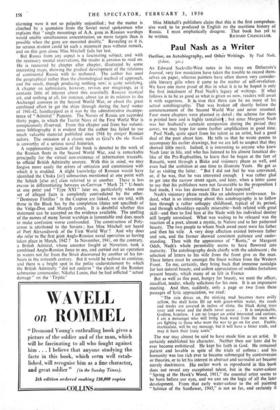Russia and the Sea
IT is unfortunate, but significant in more respects than one, that the only Soviet sailor whose likeness appears in this book should be the Admiral of the Fleet who was tried in 1948 and convicted, pour decourager les autres, on a charge of over-close co-operation during the war with his British comrades-in-arms. A mention of this, and perhaps of the three other former Admirals now serving sentences of "corrective labour" for a similar offence, would have put much of the information contained in this voluminous work in a better perspective.
A minimum of teshnical knowledge is desirable in those who aspire to write a maritime history, and this is particularly important in the case of Russia, in order that the author can sift such nautical information as is allowed to slip through the fine mesh of the Soviet Informburo and the Society for Cultural Relations with the U.S.S.R. (to whom Miss Mitchell acknowledges her obligations). A few simple tests will suffice. For the Tirpitz ' to be described as a pocket-battleship is disconcerting, and the placid acceptance of a multiplicity of " aircraft-carriers " in the Black Sea would be alarming were it not so palpably unjustified ; but the matter is clinched by a quotation from the 'Soviet naval spokesman who explains that "single mountings of A.A. guns in Russian warships would enable simultaneous concentration, on more targets than is possible when the guns are mounted doubly." Revealing as it is, no serious student could let such a statement pass without remark, and on this gem alone Miss Mitchell fails her test.
But Russia from any aspect is a fascinating subject, and, with the necessary mental reservations, the reader is anxious to read on. 'He is reassured by chapter after chapter, illustrated by some interesting maps, showing the gradual development of the relations of continental Russia with its seaboard. The author has used the geographical rather than the chronological method of approach, and the result, though producing nothing new; is quite satisfying. A chapter on icebreakers, however, revives our misgivings, as it contains little of interest about this essentially Russian nautical art, and nothing at all, for instance, about ice in its relation to the Archangel convoys in the Second World War, or about the great combined effort to get the ships through during the hard winter of 1941-42, handicapped as it was by the administrative incompe- tence of " Admiral " Papanin. The Navies of Russia are accorded thirty pages, in which the Tsarist Navy of the First World War is conspicuously ill-served. From this chapter and from her volumi- nous bibliography it is evident that the author has failed to use much valuable material published since 1948 by émigré Russian sailors. The omission of a classic such as Graf's On the Novik is unworthy of a serious naval historian.
A supplementary section of the book is devoted to the work of the Russian fleets in the Second World War, and is remarkable principally for the virtual non-existence of information traceabli to official British Admiralty sources. With this in mind, we may forgive more easily the errors of omission and commission with which it is studded. A slight knowledge of Russian would have identified the Chuka [sic] submarines mentioned at one point with the Schtch [also sic] class referred to at another. There is less excuse in differentiating between ex-German "Mark 21" U-boats at one point and "Type XXI " later on, particularly when one set of alleged facts is completely contradicted by the other. "Destroyer Flotillas" in the Caspian are linked, we are told, with those in the Black Sea by the completion (dates not specified) of the Volga-Don and Manych canals. It is doubtful whether this statement can be accepted on the evidence available. The spelling of the names of many Soviet warships is lamentable and does much to make confusion worse confounded. The construction of Poly- arnoe is attributed to the Soviets ; has Miss Mitchell not heard of Port Alexandrovsk of the First World War ? And why does she refer to the first joint Anglo-Russian naval operation as having taken place in March, 1942? In November, 1941, on the contrary, a British Admiral, whose ancestor fought at Navarino, took a combined Anglo-Russian force to sea, and carried out an operation in waters not far from the Strait discovered by another of his for- bears in the sixteenth century. But it would be tedious to continue, and there is a bright spot in the polite understatement by which the British Admiralty "did not endorse" the claim of the Russian submarine commander, Nikolai Lunin, that he had inflicted "actual damage" on the Tirpitz.' Miss Mitchell's publishers claim that this is the first comprehen- sive work to be produced in English on the maritime history of Russia. I must emphatically disagree. That book has yet to



































 Previous page
Previous page